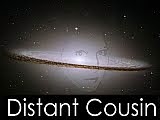Read an E-book Week is March 6-12, 2011. This year we're doing something a little different.
The Distant Cousin stories have been hugely popular as e-books (indeed, they're ideal as e-books), and if you haven't at least tried
the first one, we hope you will. Instead of mentioning them again, however, in the interest of promoting e-reading in general, we'd like to recommend some other e-book titles. We have read (and reviewed) all of them.
You're invited to check them out. Remember, Kindle readers can sample 10% of any for free. Smashwords is more generous. The size of the free sample may vary, but in the case of the Distant Cousin series, it's half the book! Most of the books below are also budget priced as Kindle editions. If you were to purchase them all, you'd very nearly pay for your Kindle!
The Saga of Beowulf, by R. Scot Johns
Yes, THAT Beowulf, the one you had to read about in grade school. But this one is actually readable, actually fun: it's a novel, full and complete, and a steal for the price.
We Hear the Dead, by Dianne Salerni
A carefully researched historical novel, YA but suitable for all readers, about the Fox sisters, who accidentally founded the Spiritualism Movement.
Knoxville 1863, by Dick Stanley
Outstanding, carefully researched historical fiction that brings the Civil War alive.
Gone Over, by David Chacko
Both novels are about the life of Benjamin Potter, a real but little known (except perhaps to historians) Revolutionary Era American whose wide experiences (on both sides) bring to life the feel of those troubled, exciting times.
God's Money: A novel based on actual events, by Tad Hutton
A short, highly entertaining story involving modern pirates and the colorful, multicultural peoples of the waters of Southeast Asia.
The Adelsverein Trilogy, by Celia Hayes
The Gathering
The Sowing
The Harvesting
Beginning with German immigrants settling in (and creating) Fredericksburg, Texas after the Goliad Massacre, just before Texas Independence, these books takes the story of several families almost to World War I. Entertaining and well-researched.
The Hummingbird's Daugher, by Luis Urrea
The utterly fascinating true story of Teresita Urrea, the author's great aunt, who became a healing woman, a near saint, and such a threat to the Mexican government that she was deported to the United States.











